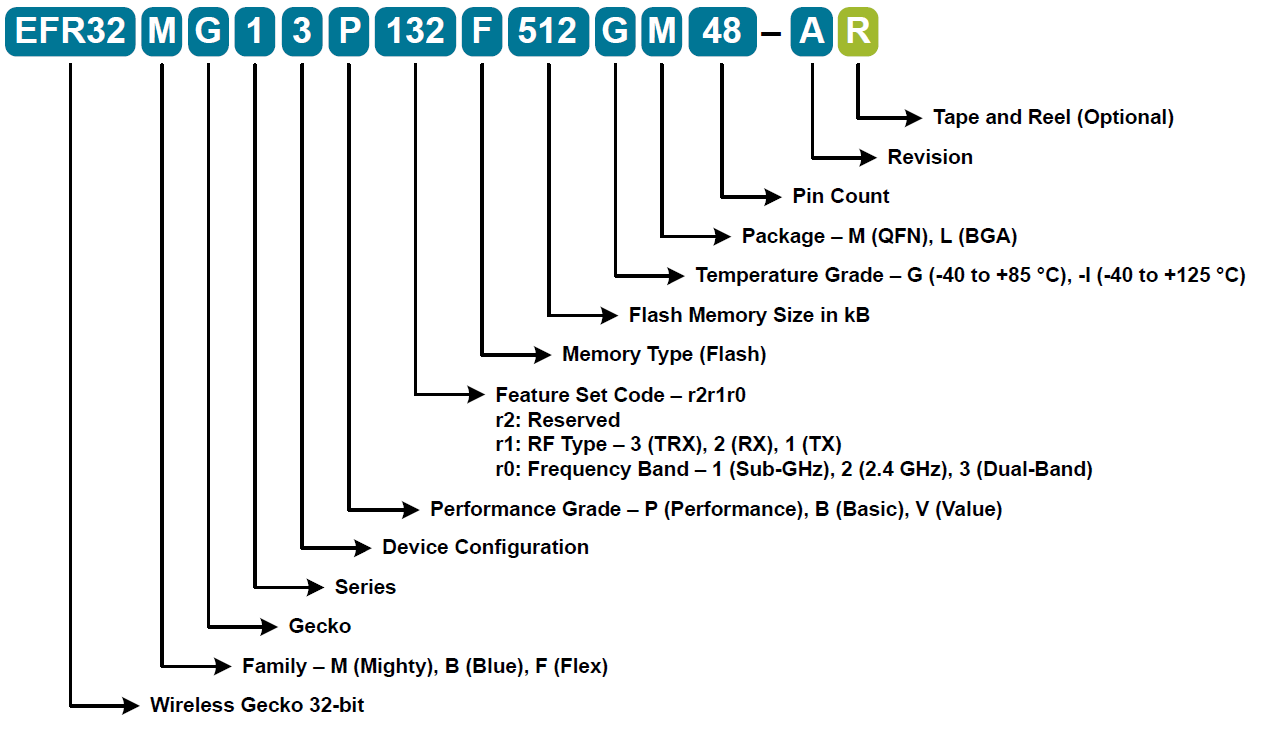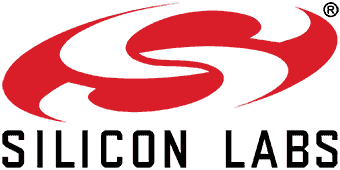-
Notifications
You must be signed in to change notification settings - Fork 68
Wireless Products Protocols and Applications
English | 中文
Table of Contents
-
Introduction:
Silicon Labs' proprietary wireless devices provide high-performance wireless connectivity and ultra-low power 32-bit microcontroller options. With support for major frequency bands in the 142 to 1050 MHz range and 2.4 GHz, these devices can be used to develop many wireless communication systems.
-
Chip name conventions:
For proprietary products, there are many FG type chips which are classified with generations, packages, flash size, temperature grades, output power levels, and frequency bands. The general name convention is as follows:

As you can see from the name convention, the proprietary chips include four series such as FG1, FG12, FG13,and FG14. The chips are classified with P (Performance), B (Basic), and V (Value) performance grades. The chips are Tx/Rx type which include sub-G band, 2.4GHz band, and sub-G& 2.4GHz bands. The chips are classified with 2 temperature range as -40°-+85° and -40°-+125°. And there are many packages(QFN32, QFN40, QFN48, QFN68, and BGA125) to select.
-
Applications:
Meters(Gas, water, electricity), Door locks, Electronic lables, Wireless toys, Wireless ranch, Remote controllers, etc.
-
Introduction:
Silicon Labs is the vendor of choice for OEMs developing Zigbee networking into their products. The Silicon Labs Zigbee platform is the most integrated, complete and feature rich Zigbee solution available — a family of Wireless SoCs, based on Arm® Cortex® processor and 2.4 GHz transceiver, together with the most reliable, scalable and advanced Zigbee software and supported by best-in-class development tools.
-
Chip name conventions:
For Zigbee/Thread products, there are also many MG type chips which are classified with generations, packages, flash size, temperature grades, output power levels, and frequency bands. The general name convention is as follows:

As you can see from the name convention, the Zigbee/Thread chips include 2 variants such as MG12 and MG13 for EFR32MG1x series 1 chips, and 2 variants as MG21 and MG22 for EFR32MG2x series 2 chips. The Zigbee/Thread chips only have P performance grade. The chips are Tx/Rx type which include sub-G band, 2.4GHz band, and sub-G& 2.4GHz bands. The chips are classified with 2 temperature range as -40°-+85° and -40°-+125°. And there are many packages(QFN32, QFN40, QFN48, QFN68, and BGA125) to select.
There are also many SiP and PCB modules such as MGM12P, MGM13P/S, MGM210P/L for customer selection.
-
Applications:
Home and Building Automation, Beaconing, Lighting and Switching, Asset Tracking, Remote Control via Internet, etc.
-
Introduction:
Add Bluetooth® 5, Bluetooth 5.1 or Bluetooth mesh connectivity into sports and fitness, consumer electronics, beacons, and smart home applications with Bluetooth SoCs, certified modules and software from Silicon Labs. Take advantage of the latest Bluetooth low energy technologies including Bluetooth 5 and Bluetooth mesh with Silicon Labs wireless stacks and advanced development tools, and explore pre-programmed module solutions with Bluetooth Xpress.
-
Chip name conventions:
For BLE products, there are many BG type chips which are classified with generations, packages, flash size, temperature grades, output power levels, and frequency bands. The general name convention is as follows:

As you can see from the name convention, the BLE chips include 3 variants such as FG1,FG12, and FG13 for EFR32BG1x series 1 chips, and 2 variants as BG21 and BG22 for EFR32BG2x series 2 chips.The BLE chips are classified with P (Performance), B (Basic), and V (Value) performance grades. The BLE chips are Tx/Rx type which include sub-G band, 2.4GHz band, and sub-G& 2.4GHz bands. The BLE chips are classified with 2 temperature range as -40°-+85° and -40°-+125°. And there are many packages(QFN32, QFN40, QFN48, QFN68, and BGA125) to select.
There are also many SiP and PCB modules such as BGX13P/S, BGM121/3, BGM111/3/S, BGM13P/S, BGM210P/L for customer selection.
-
Applications:
Home Automation, Beaconing, Sport and Fitness, Asset Tracking, AoA/AoD, etc.
-
Introduction:
The Z-Wave ecosystem is comprised of the world’s largest selection of interoperable smart product for home and business. It provides the most advance security for home devices and controllers. It will Unlocks the Full Potential of the Smart Home.
-
Chip name conventions:
For Z-Wave products, it will also comply the name conventions above. But now, there is only one type chip called EFR32ZG14P231F256GM32. It is ZG14 serie chip, and it has P performance grade with +13dBm maximum output power. And it only works at sub-G band and at -40°-+85° temperature range. There is only 32 pin package available. There is one SiP modules (ZGM130S) for customer selection.
-
Applications:
Secure door locks with battery powered, Smart Thermostats, Control panels , And many other home automation applications.
 Home |
Home | ![]() Zigbee |
Zigbee | ![]() Bluetooth |
Bluetooth | ![]() ZWave |
ZWave | ![]() Proprietary |
Proprietary | ![]() Hardware |
Hardware | ![]() Common
Common
All resources of this repository are released under license CC BY-NC-ND 4.0 
